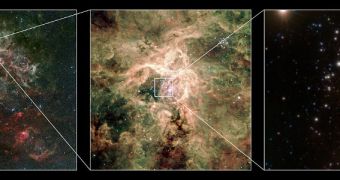Astronomers recently managed to discover the most massive star in the Universe. The behemoth, estimated to have about 300 times the weight of the Sun, and millions of times its luminosity, exceeds the previously-accepted limit of how large stars can be by 200 percent, and sets new records for size and luminosity. Experts say that the giant structure had this amazing weight at birth, and that it now looses some of its mass through incredibly intense solar winds. Undoubtedly, if exoplanets exist around this star, they are drenched in potent waves of radiation, experts believe.
The discovery was made using the Very Large Telescope, which belongs to the European Southern Observatory (ESO). The instrument, located in the Chilean Atacama desert, at Cerro Paranal, consists of four main mirrors, and four secondary ones, and works on optical interferometry. This means that the light captured by all of these machines is combined to provide an impressive single image. What this does is it allows for the four main telescopes to snap images with the same quality as if they were taken by a single instrument, with a mirror whose length is equal to the maximum distance between any two mirrors of the VLT.
The massive young star was discovered as experts were investigating the NGC 3603 and RMC 136a stellar clusters in detail. The team behind the study was using both the VLT and data collected by the NASA Hubble Space Telescope in previous surveys of the sky. The RMC 136a cluster (more often known as R136), is located in the Tarantula Nebula, inside the Large Magellanic Cloud. This galaxy is located very close to the Milky Way, and is part of the Local Group. The LMC is located some 165,000 light-years away from Earth.
Astronomers from the University of Sheffield, in the UK, determined that some of these stars had surface temperatures of up to 40,000 degrees Celsius, which makes them at least seven times hotter than the Sun. The group also determined that the size and age of the stars dictate that they were more than 150 solar masses in weight when they first appeared. “Unlike humans, these stars are born heavy and lose weight as they age. Being a little over a million years old, the most extreme star R136a1 is already ‘middle-aged’ and has undergone an intense weight loss program, shedding a fifth of its initial mass over that time, or more than fifty solar masses,” University of Sheffield Astrophysics professor Paul Crowther says.

 14 DAY TRIAL //
14 DAY TRIAL //